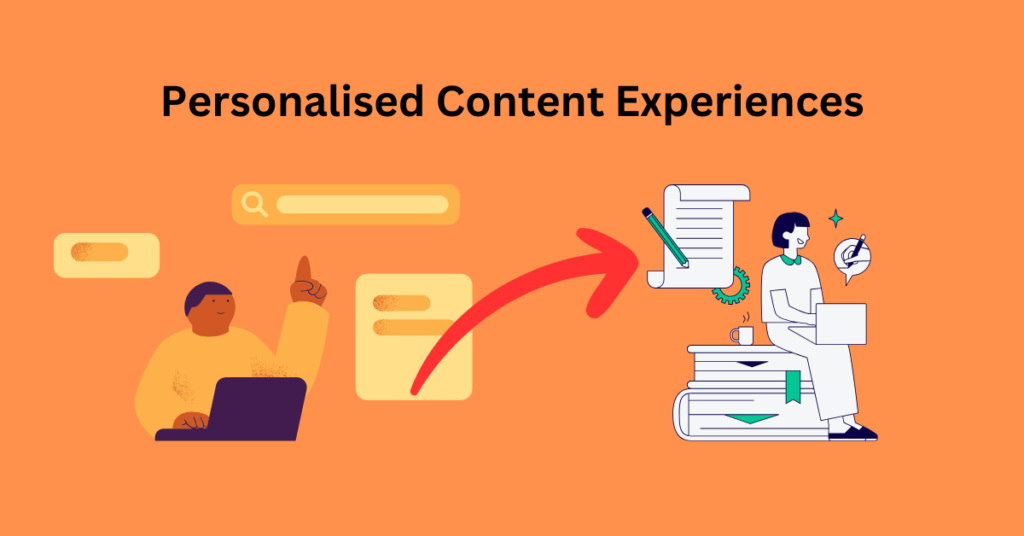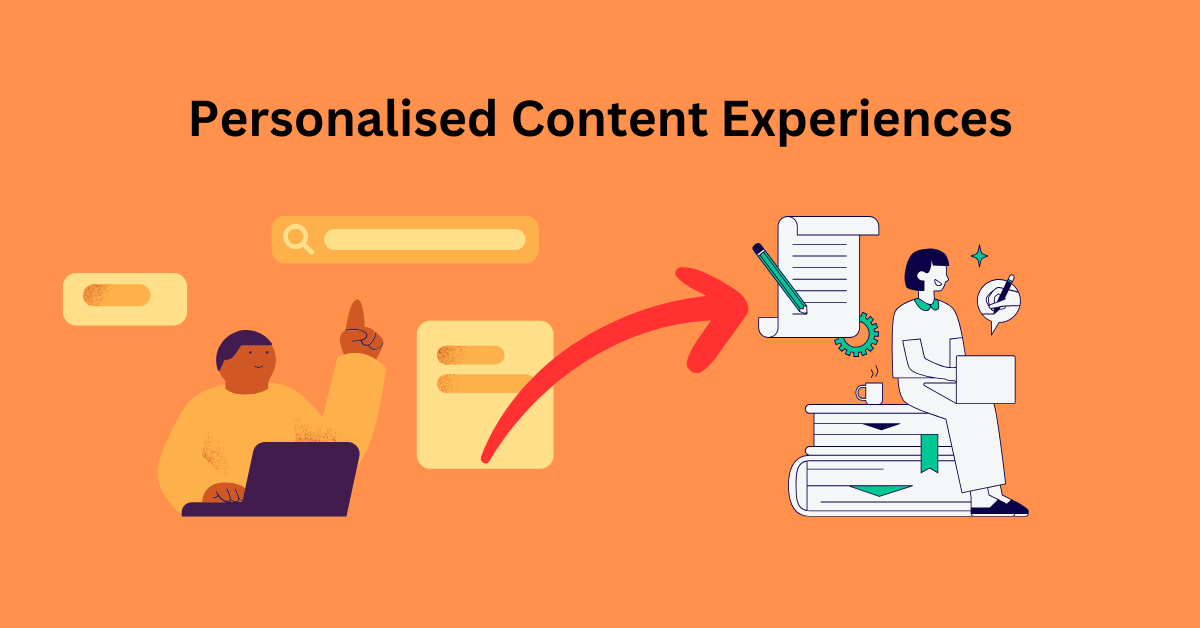Table of Content
Personalised Content Experiences
What Are Personalised Content Experiences?
The Importance of Personalized Content in 2024
- Increased Engagement and Retention
- Improved Conversions and Sales
- Enhanced Customer Loyalty and Satisfaction
- Meeting Consumer Expectations
The Technologies Powering Personalized Content
- Artificial Intelligence (AI) and Machine Learning (ML)
- Customer Data Platforms (CDPs) CDPs
- Natural Language Processing (NLP)
- Behavioural Targeting and Predictive Analytics
Key Strategies for Creating Personalised Content Experiences
- Segment Your Audience
- Use Dynamic Content
- Leverage Recommendation Engines
- Personalised Email Marketing
- Offer Tailored Content Based on User Journey
Measuring the Impact of Personalized Content Experiences
- Engagement Metrics
- Conversion Rates
- Customer Retention and Lifetime Value (CLV)
- Revenue Growth
Conclusion
Personalised Content Experiences

In today’s fast-paced digital world, consumers are bombarded with content at every turn—whether they’re scrolling through social media, browsing e-commerce sites, or reading blogs. As the volume of digital content grows, it’s no longer enough for businesses to simply create generic material. Personalised content experiences have emerged as a game-changer in 2024, allowing brands to cut through the noise and deliver relevant, tailored interactions that resonate with their audiences.
In this article, we’ll explore the growing importance of personalised content, the technologies enabling these experiences, and how brands can effectively harness the power of personalization to engage users and drive growth.
What Are Personalised Content Experiences?
Personalised content experiences are interactions that are tailored to an individual’s preferences, behaviour, interests, and demographics. These experiences use data to deliver the right message, at the right time, and in the right format—whether it’s a personalised product recommendation, a customised email, or a dynamic website experience.
Moreover,Personalization goes beyond simply addressing a customer by name; it’s about crafting unique journeys based on users’ past actions and predictive insights.When done correctly, personalised content creates a more engaging, relevant, and impactful experience for the user.
The Importance of Personalized Content in 2024
In 2024, consumers expect personalization as part of their digital experiences. They’re more likely to engage with content that speaks directly to them, and they increasingly demand that brands understand their needs. Here’s why personalization is critical
- Increased Engagement and Retention
Moreover,Personalization improves customer engagement by making content more relevant.When users see information, products, or services tailored to their specific interests, they are more likely to spend time on the website or app, explore other pages, and come back for future interactions. This, in turn, boosts customer retention.
- Improved Conversions and Sales
Personalization is also key to increasing conversions. When users are presented with content that aligns with their needs or stage in the buyer’s journey, they’re more likely to make a purchase. For instance, personalised product recommendations based on a customer’s previous purchases or browsing history can drive more meaningful interactions and lead to higher sales.
- Enhanced Customer Loyalty and Satisfaction
Consumers appreciate when brands go the extra mile to tailor their experience. Moreover,This not only makes them feel valued but also builds trust.Personalised experiences can increase customer loyalty as users associate your brand with quality, attention, and care. In 2024, businesses that fail to personalise risk losing customers to competitors who do.
- Meeting Consumer Expectations
In today’s digital world, personalization is expected. As artificial intelligence (AI) and machine learning (ML) tools become more accessible in 2024, consumers increasingly expect brands to use them to deliver seamless, personalised interactions.
The Technologies Powering Personalized Content
Personalized content is increasingly central to digital marketing, with technologies allowing brands to deliver highly relevant experiences tailored to individual users. Several key technologies are driving this shift, each playing a unique role in crafting and delivering personalized experiences. Here’s an overview of these technologies:
- Artificial Intelligence (AI) and Machine Learning (ML) AI and ML are the engines of personalization.
These technologies analyse massive amounts of customer data—such as browsing behaviour, purchase history, and interactions with previous content—and use it to predict future actions. Through predictive analytics, AI can dynamically adapt content in real time, creating more meaningful and relevant experiences.
Moreover,For example, AI-driven algorithms power recommendation engines on e-commerce websites like Amazon or Netflix. These platforms curate products, movies, or shows based on user preferences, making every user’s experience unique and relevant to their interests.
- Customer Data Platforms (CDPs)
CDPs are essential for personalising content at scale.Moreover, These platforms collect, unify, and manage customer data from multiple sources (e.g., websites, apps, emails, social media) to create a single customer view. This data can then be used to trigger personalised content based on specific customer segments or behaviours.
In addition,By integrating CDPs with marketing automation tools, brands can deliver personalised email campaigns, dynamic website experiences, or targeted ads based on real-time customer data.
- Natural Language Processing (NLP)
NLP is another key technology that enables brands to understand and respond to user preferences. It powers chatbots, voice search optimization, and content generation tools that create personalised interactions in a conversational manner. For example, AI-powered chatbots on e-commerce websites can guide users through personalised shopping journeys, answering questions, and suggesting relevant products.
- Behavioural Targeting and Predictive Analytics Behavioral targeting uses data from previous user actions
such as clicks, purchases, or page views to predict future behaviour. Predictive analytics takes this a step further by analysing patterns and trends in user data to anticipate what a customer might want next. This allows brands to create highly customised experiences, such as sending a timely product offer or presenting content tailored to where the user is in the customer journey.
Key Strategies for Creating Personalised Content Experiences
- Segment Your Audience
Moreover,Segmentation is the foundation of effective personalization. In addition,By dividing your audience into smaller groups based on demographics, behaviours, interests, or engagement levels, you can deliver content that speaks to each segment’s unique needs. Whether it’s sending an email campaign to first-time buyers or retargeting customers who abandoned their cart, segmented marketing ensures that your messaging is more relevant and effective.
- Use Dynamic Content
Dynamic content automatically changes based on user behaviour, preferences, or demographics. For example, an e-commerce website might display different homepage banners to new visitors compared to returning customers. Similarly, a travel website could show personalised vacation packages based on a user’s past searches or destinations.
Dynamic email content is also popular, where subject lines, images, or product recommendations change depending on the recipient’s actions or preferences. This can significantly improve open rates and click-through rates.
- Leverage Recommendation Engines
One of the most effective personalization strategies is using recommendation engines. Whether you’re recommending articles on a blog, videos on a streaming service, or products on an e-commerce site, AI-driven recommendation engines help keep users engaged and guide them toward making a purchase.
- Personalised Email Marketing
In addition,Personalised email campaigns continue to be one of the most effective ways to engage users in 2024. Moreover,By leveraging customer data, you can send highly targeted emails with personalised subject lines, product recommendations, or exclusive offers. Personalization can be as simple as addressing the recipient by name or as advanced as tailoring the content based on recent browsing activity.
- Offer Tailored Content Based on User Journey
Moreover,Different users are at different stages of the customer journey, and your content should reflect that. For instance, first-time visitors may need educational content or product information, while returning customers might prefer recommendations or offers based on their past behaviour. By mapping out the customer journey and tailoring content accordingly, you can provide a seamless, personalised experience.
Measuring the Impact of Personalized Content Experiences
- Engagement Metrics
Moreover,These include metrics such as click-through rates (CTR), time spent on the website, page views, and bounce rates. Personalization typically leads to higher engagement, as users interact more with content that is relevant to them.
- Conversion Rates
Moreover,Whether it’s signing up for a newsletter, downloading a guide, or making a purchase, conversion rates will help you gauge how effectively your personalised content is driving actions.
- Customer Retention and Lifetime Value (CLV)
Moreover,A key benefit of personalised content is its ability to improve customer retention and increase CLV. By delivering consistent and relevant experiences, brands can foster loyalty and encourage repeat business.
- Revenue Growth
Moreover,Ultimately, personalization should lead to increased revenue. Tracking sales generated from personalised content—whether through email marketing, dynamic website experiences, or product recommendations—will show the direct financial impact of your strategy.
Conclusion
In conclusion, As we move into 2024, personalised content experiences are no longer a luxury—they’re a necessity. Consumers expect brands to understand their preferences and deliver tailored content that meets their unique needs. By leveraging AI, machine learning, and data-driven insights, businesses can create personalised journeys that drive engagement, increase conversions, and build long-lasting relationships with their customers.
In this competitive digital landscape, brands that prioritise personalization will stand out from the crowd and thrive in the age of hyper-personalised content.


Leave a Reply